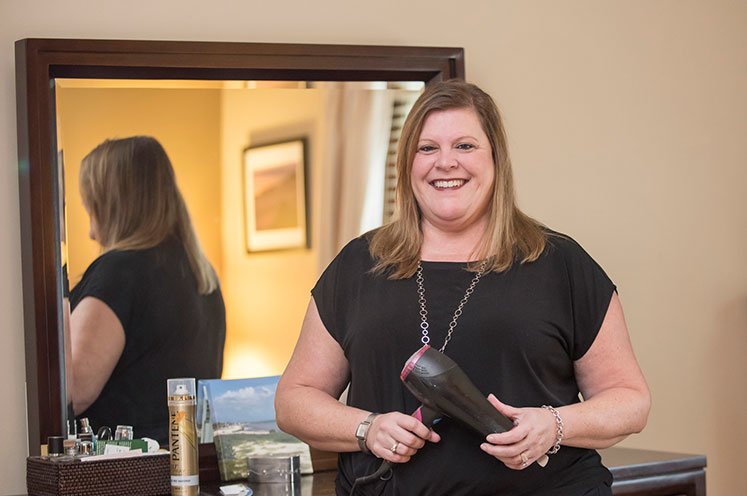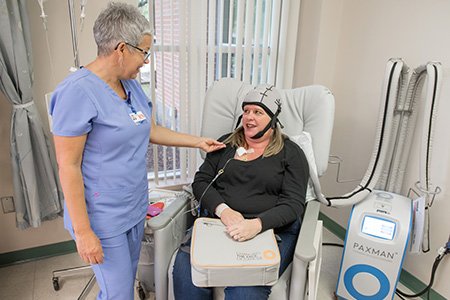Laura's Story
When Laura was told she’d need chemotherapy, she decided to dig into her pocket for an innovative ice-free cool cap to save her hair, not a wig.
Chemotherapy is the treatment most commonly associated with cancer, but not every breast cancer patient will need it. Medical oncologists at Henry Ford work closely with you to customize the most appropriate treatment for your breast cancer.
Chemotherapy uses drugs to damage or destroy cancer cells. We inject or infuse a combination of medications into the bloodstream to attack cancer cells in the breast or, if the cancer has spread, in other areas of the body. It may be used alongside treatments such as breast cancer surgery, radiation therapy, or biological therapy.

When Laura was told she’d need chemotherapy, she decided to dig into her pocket for an innovative ice-free cool cap to save her hair, not a wig.
Our medical oncologists track the latest in breast cancer chemotherapy treatments so you get the most advanced therapy possible. There are a few terms to understand about types of chemotherapy:
Every cancer responds differently to treatment. But chemotherapy causes the cancer to disappear or shrink in 30 to 60 percent of patients with advanced breast cancer.
Your breast cancer chemotherapy regimen may require an outpatient infusion treatment at the hospital, or it may allow you to simply take a pill at home.
Chemotherapy may cause you to feel tired or suffer from chemo brain (mental fogginess or difficulty focusing). You also will be more susceptible to infection after chemotherapy treatment. Your doctor can help you manage these or other symptoms you may experience.
Henry Ford now offers an innovative cooling cap option that prevents or reduces hair loss associated with chemotherapy. For many patients, having the ability to maintain their hair can have a strong psychological impact and strengthen their ability to confront breast cancer.
 We use the Paxman Scalp Cooling System, an ice-free approach that provides constant and uniform cooling to the scalp. The FDA-approved cooling cap constricts blood vessels and reduces the flow of chemotherapy to the scalp. Fewer drugs are distributed into the tissue of the scalp, so the hair follicles have less contact with the chemotherapy. That means less hair loss.
We use the Paxman Scalp Cooling System, an ice-free approach that provides constant and uniform cooling to the scalp. The FDA-approved cooling cap constricts blood vessels and reduces the flow of chemotherapy to the scalp. Fewer drugs are distributed into the tissue of the scalp, so the hair follicles have less contact with the chemotherapy. That means less hair loss.
Constantly flowing liquid in the cooling cap picks up heat from the scalp and moves it back into a cart refrigeration system where it is re-cooled. The cap remains on the patient’s head for a total of approximately four hours – before, during, and after chemotherapy treatments.
Most types of chemotherapy can be used with the cap, but the results will vary greatly, ranging from 60 to 20 percent of hair saving. We consider maintaining 50 percent of hair to be successful. Our team can provide an estimate of hair loss depending on the type of chemotherapy you will be receiving and your dosing schedule.
Scalp cooling is not available for patients with metastatic breast cancer. This advanced cancer requires ongoing chemotherapy to prevent cancer from travelling to different parts of the body, including the scalp.
Henry Ford is working to expand health insurance coverage for the cooling cap system; it is currently not covered by insurance.
Researchers are always investigating new breast cancer chemotherapy treatments. Our breast cancer patients at times have access to clinical trials for these new treatments. Ask your cancer team whether a clinical trial might be right for you.
We use cookies to improve your website experience. By using this site, you agree to our Terms of Use. Read our Internet Privacy Statement to learn what information we collect and how we use it.